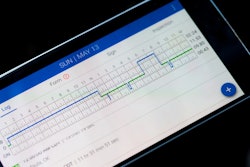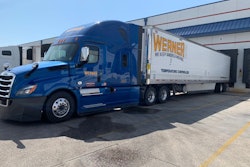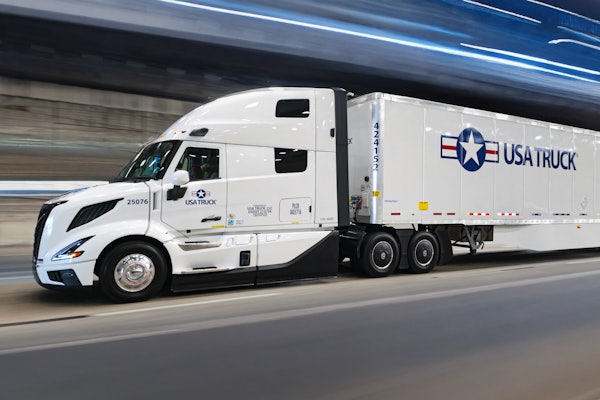This story was originally published October 2019. The U.S. DOT announced May 14, 2020 it has finalized overhauled HOS regs, which are slated to take effect later this year.
 Soona Lee, director of regulatory compliance at EROAD, spoke to its customers at a user conference in Portland on Oct. 24.
Soona Lee, director of regulatory compliance at EROAD, spoke to its customers at a user conference in Portland on Oct. 24.A significant number of short-haul fleets will stop using electronic logging devices if the Federal Motor Carrier Safety Administration makes proposed changes to the hours-of-service (HOS) rule, according to a survey by EROAD.
EROAD supplies fleet management, ELD and electronic tax systems. Results from the recent survey of 272 motor carriers were shared with CCJ during the company’s user conference in Portland on Thursday, Oct. 24.
The agency’s HOS rule proposal would extend the radius of the short haul exemption to 150 air miles. Currently, fleets operating within a radius of 100 air miles are not required to keep a record of duty status (RODS) or take a 30-minute break. In addition, short haul fleets would have a maximum on-duty limit of 14 hours, up from 12 hours.
The survey by EROAD found that 27% of motor carriers that use the exemption today do not have their short haul drivers using ELDs. With the proposed changes, 61% indicated they would not plan to use ELDs for their short haul drivers. That percentage jumps to 69 for fleets with less than 50 trucks. Carriers with short haul operations who indicated they will continue using ELDs (40% of respondents) say the technology will support other business needs for IFTA, IRP, dispatch, operations and driver behavior.
Moving to a 14-hour limit for the exemption appears to be the most impactful change: 58 percent of respondents that use the short haul exemption say the 12-hour on-duty limit, not the 100-mile radius, is their most frequently exceeded criteria.
“Long lines at loading racks and heavy traffic can cause the 12-hour rule to be exceeded on occasion,” said Mike Elmenhorst, safety manager of Groendyke Transport, a tank-truck carrier based in Enid, Okla.
 On Oct. 24 at the EROAD user conference, Joe DeLorenzo (right), FMCSA director, office of enforcement, said the agency is moving quickly on its HOS rule proposal.
On Oct. 24 at the EROAD user conference, Joe DeLorenzo (right), FMCSA director, office of enforcement, said the agency is moving quickly on its HOS rule proposal.Adam Gallagher, safety director of Devine Intermodal in West Sacramento, Calif., thinks only the 12-hour criteria should change to allow carriers to be more productive. “100 air miles are enough,” he said. “If FMCSA makes it 150, it will be abused. It is already being abused at 100 air miles.”
Overall, 20% of respondents indicated they would change how they operate if granted a 14-hour on-duty limit and 150 air mile radius, and 32% were “not sure yet.” Combining these two responses shows that as many as 52% of fleets could adjust their operations with the new short haul criteria.
In light of these results, Soona Lee, director of regulatory compliance for EROAD, said the company is thinking of developing a short haul application for its ELD system. The new application would switch a driver automatically from short haul to a record of duty status if the driver exceeds the short haul criteria for air miles or time.
Interest in adverse conditions
Another significant change in the HOS rule proposal would increase the maximum 14-hour on duty period by two hours for “adverse conditions.” The current rules allow a driver to log two extra hours of driving time, on top of the current 11-hour limit, as long as driver stays within the maximum 14-hour on duty period. The proposed rule would allow a driver to operate a vehicle for up to 16 hours in the event of an adverse condition.
Nearly one-third of fleets currently do not allow their drivers to use the adverse conditions exemption, according to survey results. If the proposed rule becomes law, 73% of fleets would allow more drivers to use the exception and 21% would allow fewer drivers. Six percent would not let their drivers use the exception.
A significant number of respondents suggest they would need further clarification on the definition of qualifying weather as well as unusual road and traffic conditions.
“Could I use [the exception] if I didn’t know about an accident and then I got in a route where there was an accident?” is a common question fleets have about using the exemption, Lee says. “[Fleets] are wanting more clarity.” Another area the FMCSA will need to clarify is who should make the decision — the driver or dispatcher?
Extending the duty cycle
The survey found that a majority of carriers are in favor of the proposal to split up the 10-hour off-duty rest period, either by taking eight or seven hours in the sleeper berth, and then spending two or three hours in off duty status. The off-duty breaks would not count towards a driver’s 14-hour on-duty window.
Under this scenario, drivers could essentially go 17 hours without taking a rest break, Lee says. Twenty percent of carriers indicated they would not be comfortable with having their drivers operate such long hours. Even so, a significant majority support the proposal that would extend the 14-hour duty period with off-duty rest.
The most popular change in the HOS proposal, according to the survey, is allowing drivers to satisfy the 30-minute break requirement by using “on-duty, not driving” time and by using off-duty status. Sixty percent of carriers are in favor of allowing loading, unloading and other on-duty activities to quality as rest breaks. In addition, under the proposal, a 30-minute break would only be required after 8 hours of driving time, instead of 8 hours of on-duty time.
The 272 survey responses came from a diverse group of motor carriers that included EROAD’s customer base and commercial and private fleets that EROAD contacted by working with national and state trucking associations. Participation was strongest among small and medium-sized fleets. The average fleet size among respondents is 288 trucks and the median fleet size is 25 trucks. To download a free copy of the full report, click on this link.











